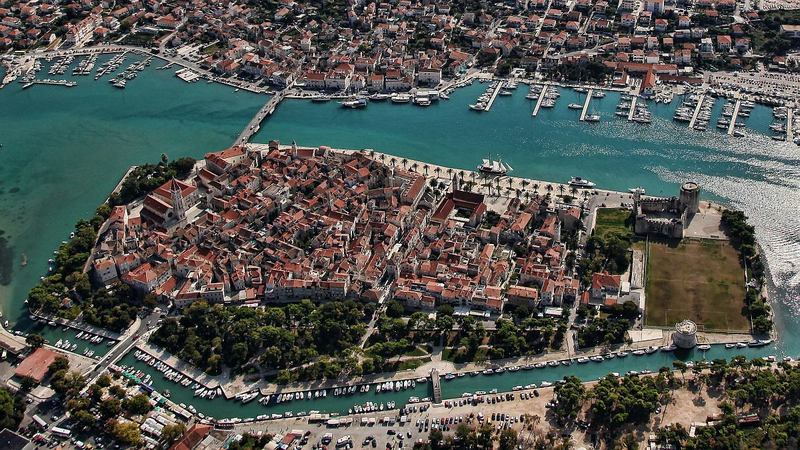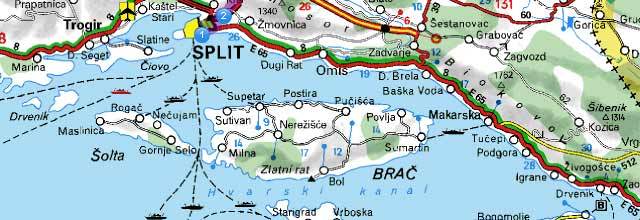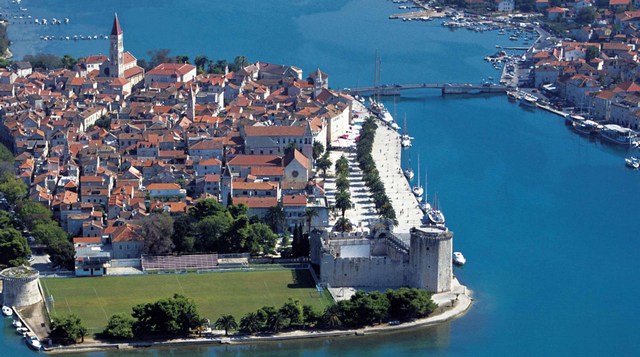 | The Croatia Conservation Field School adds an exciting international element to the University of Oregon's Historic Preservation Program. It is an intensive program that allows students to gain hands-on experience in a culturally rich setting. Students will explore villages, while learning the history of the area of the city of Trogir (protected by UNESCO, on the photo) and on the island of Brač, documenting and analyzing important structures, and participating in a hands-on building project. The program is open to undergraduate and graduate students. |

| Croatia Summer Conservation Field School June 20 - July 18, 2014 Sponsored by the University of Oregon Historic Preservation Program, the School of Architecture and Allied Arts, and the Ministry of Culture, Trogir, Croatia. Overview The Croatia Conservation Field School adds an exciting international element to the University of Oregon's Historic Preservation Program. The Croatia Field School specializes in the conservation of vernacular settings and cultural landscapes, and the School of Architecture and Allied Arts' focus on sustainable design. The Croatia Conservation Field School is an intensive program that allows students to gain hands-on experience in a culturally rich setting. Students will explore villages, while learning the history of the area, documenting and analyzing important structures, and participating in a hands-on building project. The program is open to undergraduate and graduate students and is primarily intended for students in historic preservation, architecture, landscape architecture, and other related academic fields. Students participating in this program will be registered at the University of Oregon and will receive UO credits for courses taken in Croatia. Traditional Stone Buildings Along the Dalmatian Coast [PDF] 16.6MB, 136 pages Site Information: Trogir, Brac, and the Dalmatian Coast FIELD TRIPS: The field school is ideally situated in a heritage-rich region of the Dalmatian Coast and is surrounded by many World Heritage Sites such as Diocletian's Palace in Split to the south and the Cathedral of St. James in Sibenik to the north. The city of Trogir, in which the school is based, is itself a UNESCO World Heritage site dating from Roman times, though much of its architectural expression evokes the medieval period, with winding streets and towering limestone facades in the Venetian/Florentine Gothic style. These World Heritage sites and others will provide the setting for our initial orientation to the region. The tours will be led by the Ministry of Culture’s professional staff. FIELD WORK: The first session will start in Trogir, Croatia, which serves as the home base of the field school. From Trogir, the first several days are dedicated to field trips that explore vernacular villages, World Heritage sites, a cultural museum, and a National Park. Next, the school will work in the village of Dol on the island of Brac. Here we will collaborate with a local community organizations dedicated to the conservation of the cultural landscape. The area retains numerous limestone architectural features dating from Roman times and a well-preserved cultural landscape in need of documentation, analysis, and restoration. The aim of the field school is to prepare relevant documentation for the protection of those remaining elements that represent the cultural identity of the area. This session will then relocate to Pucisca, also on the island of Brac for approximately one week. Here students will participate in classes at the famous Klesarska Skola stone carving school, learning how to dress stone. While in Pucisca, students will also receive instruction in dry stone construction, will take field trips to local quarries and monasteries, and will develop field recordation drawings undertaken at Dol. The first session will be followed by a three-day intersession break in which students will be encouraged to visit important sites in the area according to their interests. Students are responsible for their own travel and accommodations during the three-day break. The second session will take place back in Dol where students will further develop their initial documentation and construction work and also embark on individual or small team projects focused on a topic of particular interest. Recent projects have included studies of water catchment systems, village organization, roof construction, stone wall systems, regional color, and a wide variety of others. The session will conclude in Trogir where final documentation and presentation work will occur. Courses Offered The Croatia Field School offers (9) credits in three separate class offerings:
The program is open to both Undergraduate and Graduate students from University of Oregon's Architecture and Allied Arts programs, and to students from outside the University of Oregon-- subject to committee approval of the application, stating the relevance of this field experience to the applicant's academic or professional goals. The credits earned can be applied toward either electives or concentration credits in Historic Preservation, or "subject area electives" in Architecture. Graduate Students in Historic Preservation will have an additional research project to undertake as partial fulfillment of their Internship/ Field Practicum requirement in our program. Students from outside the disciplines of Architecture and Allied Arts will work in a collaborative learning environment to acquire the skills necessary to contribute to the educational experience. Historic Preservation AAAP 488/688 Preservation Field Practicum: Restoration and Revitalization Efforts of Traditional Stone Environments on the Island of Brae Credits: 3 Students will work alongside University of Oregon faculty and local professionals of traditional practice to begin various phases of a rural revitalization project for the island of Brac, just off the Dalmatian Coast in the Adriatic Sea. The course will cover the fundamentals of masonry and wood construction in a hands-on format: from methods of dressing and laying stone, to wood preservation techniques in the context of traditional Croatian practices. For graduate students, expansive field notes, graphic and photo documentation will be expected. The graduate student is expected to offer a high level of written analysis and criticality in documenting the field exercise. Reference to craft explications, formal lectures, and assigned readings on traditional stone construction methods should be given complete attributions. Undergraduates, in concert with their experiential involvement, will be expected to account for their practicum in the form of a daily journal using English and Croatian technical construction terms to explain craft processes. This hands-on class also expects both 400/500 level students to develop a high level of graphic competency. Structural diagrams, construction analysis, and written documentation will be carried out under the direction of Professor Rob Thallon, while Ivan Kovacic, a Croatian master stonemason born on the Island of Brac, will instruct on the stone masonry craft of dry laid roofing methods, or dry stack stone wall construction. Historic Preservation AAAP 488/688 Reading Cultural Landscapes from a Conservation Perspective Credits: 3 Discussion groups and application models, directed by the academic instructors, will focus on heritage conservation issues, heritage protection policies, and architectural documentation requirements – comparing practices in the U.S. with those in Croatia. The history of urban growth and the changes in town form within the region will provide a framework for policy and preservation practice discussions led by professionals from the Trogir Ministry of Culture, Professors of Ethnography from the University of Zagreb, and University of Oregon faculty. Both graduate and undergraduate students will be expected to chronicle the history of urbanism and planning practices in the region surrounding Trogir through well - organized and articulate lecture notes. Graduate students, however, will have to frame these notations as part of comparative conservation policies and practices between the United States and Croatia/European Union. Among the field investigations planned are Diocletian’s Palace in Split, St. James Cathedral in Sibenik (both are World Heritage sites), the traditional Village of Brdaci, in the hinterland of Trogir, and the Eremitic monastery "Blaca" on the Island of Brac. On-sight direction from Dr. Radoslav Buzancic, Head of the Conservation Department of Trogir, and Jasna Dasovic, Conservator and Ethnographer, will compliment discussion and hands-on exercises by Dr. Kingston Heath of the University of Oregon. Historic Preservation AAAP 488/688 Field Recording Methods and Site Documentation Credits: 3 This course will train students in basic fieldwork recordation and analysis techniques, resulting in documentation such as architectural plans, textual descriptions, photographs, and interpretative drawings. Preparing for a proposed publication project will afford students the opportunity to explore a wide range of construction techniques and form/plan types through a series of case studies. In addition, students will collect ethnographic data and descriptions of certain objects and their uses, such as kitchen utensils or historic farming and milling equipment. Graduate students will be expected to produce record drawings for the Field Recording class, while Undergraduates will be expected to produce well-developed field notes and graphic measurements. Field lecture notes, interpretive sketches, and photo documentation of treatment issues are expected of both 400 and 500 level students. Rob Thallon, Associate Professor of Architecture, will direct the recordation exercises. A studio space with design materials will be provided by the host Ministry of Culture, Croatia at the Brac field site. To place the recordation exercises in context, Cultural Landscape analysis and field interpretation methods will be offered under the direction of Jasna Dasovic, Conservator of the Conservation Department of Trogir, and Dr. Kingston Heath, Graduate Program Director in Historic Preservation at the University of Oregon. Course Requirements In addition to the coursework and activities described above, each student is expected to keep an illustrated journal with entries summarizing daily activities with notes and observations. The journal is meant to record all aspects of the work project – coursework, field trip lecture notes, personal observations, and field drawings. The academic instructors will review the journals and hold recordation pinups in meetings with the students at the mid point and at the conclusion of the course. Students are required to turn in a copy of the journal and all drawings for grading. Full participation in safety orientations and all work sessions is required. Notify the director of the program of any physical concerns or limitations you have so that accommodations can be made. There will be a course reader and required texts. Graduate students in the Historic Preservation Program are required to complete an additional two-week research project (approved by the Director) to fulfill the 120-hour internship requirement. Field School Instructors Dr. Kingston Heath is a Professor of Historic Preservation and the Director of the University of Oregon's Graduate Program in Historic Preservation. 2013 will mark his eighth year teaching in an international field school. He has authored two books on Vernacular Architecture theory and practice. Rob Thallon, a registered Architect, is an Associate Professor and Associate Dean at the School of Architecture and Allied Arts, University of Oregon where he teaches design and building construction. He has authored two books on wood frame construction and is a skilled carpenter, having personally built many of his designs. His teaching emphasizes the benefits of hands-on experience. He has directed three Croatia Field Schools. Dr. Radoslav Buzancic is the former head of the Conservation Department of Trogir, a division of the Croatian Ministry of Culture. He has worked as a heritage conservationist for over 20 years, supervising and completing a number of complex restoration tasks on monuments across Dalmatia ranging from Roman architecture and Early Christian churches, to Renaissance and Baroque palaces. In 1997, together with colleagues, he successfully enrolled the town of Trogir, Croatia on UNESCO’s World Heritage List. He has received a number of national awards, including the Europa Nostra Award for the restoration of the Renaissance chapel of St. John of Trogir. As an architect, who also holds a Ph.D. in Art History, he actively participates in international exhibitions and scientific conferences, as well as lectures at the Universities of Split and Dubrovnik. He now directs conservation programs in Split Jasna Dasovic is a conservator for the Conservation Department of Trogir, Croatia, where she engages in restoration projects in Trogir and the surrounding area. She also conducts preservation studies that serve as the basis for rural settlement restoration and development plans, as well as urban development plans for the town of Trogir and its municipalities. She is a specialist in Croatian ethnography. Ivan Kovacic is a Croatian master stonemason born on the Island of Brac. He is one of the last remaining masons who still possess the knowledge of producing stone slabs as well as of the technique of making dry-stone roofs. He has participated in many restorations along the coast of Middle Dalmatia, covering the roofs of buildings ranging from 9th – 11th century churches, the Renaissance palaces Gospodnetic in Dol and Radojkovic in Skrip, the monastery Blaca, and many small houses in rural areas of Dalmatia. Program Facilities Students will be staying in Trogir, in Splitska on the Island of Brac near the village of Dol, and in the town of Pucisca, also on Brac. In Trogir, students reside at a hostel about a 5 minute walk from the town center. Accommodations in Splitska will be in private apartments or a hotel, and are currently being arranged. In Pucisca, lodging is at the famous stone carving school, Klesarska Skola. Program Schedule The field school will take place in two sessions from June 19 (student arrival) through July 19, 2014 (departure). Programmed activities are from June 20 through July 18, 2014. (Most U.S. flights depart one day prior to the arrival date). There will be a three-day intersession break. During this intersession, students will be encouraged to visit important sites of the area according to their interests. Some off-site exploration might include: visiting the many World Heritage Sites on the Dalmatian Coast, such as the landscape of Stari Grad Plain on the island of Hvar or the cathedrals and palaces in the Old City of Dubrovnik; exploring limestone formations and cave systems at Plitvice Lakes National Park; or experiencing the many museums, theaters, and art galleries of the Croatian capital, Zagreb. Students are responsible for locating and paying for their own accommodations during the three-day intersession break. Program Cost for Students Program fees include all course activities and tuition; housing for the period beginning June 20 and ending July 18, 2014, all meals during scheduled days (except for days off during the intersession), and tour transportation. In the four years of the program, fees have ranged from $5,100 to $5,400, and it is expected that fees will be in the same range this year. Actual fees will be announced by the final application deadline of February 15, 2014. Students will be responsible for air and ground transportation to and from Trogir, and for personal expenses during the 3-day intersession. Application Information Application Deadline: Priority deadline is January 15, 2014. Final deadline is February 15, 2014. Participants can earn graduate or undergraduate level credits from the University of Oregon. Historic Preservation Program students may use these credits to fulfill the internship/practicum requirement, upon approval by the Director. For further information contact: Professor Rob Thallon School of Architecture & Allied Arts 5249 University of Oregon Eugene, OR 97403 ph: 541-346-3631 fax: 541-346-3626 thallon@uoregon.edu Application materials can be found at the University of Oregon International Affairs Study Abroad website. http://international.uoregon.edu/croatia/dalmatian_coast Getting There The Split Airport (http://www.split-airport.hr/Split_aerodrom_en.htm) is the closest airport to Trogir. To get there, it is easiest to fly to a major European hub such as Amsterdam, Munich, or Paris, and then take Croatia Airlines (www.croatiaairlines.com) into the country. While many travel agents and websites will book you all the way through from the U.S., it is also worthwhile to investigate booking your international flight and your continental European flight separately, as there are many budget airlines operating out of smaller European airports. Source hp.uoregon.edu |
Kate Alfirevia singing Švet Ivane - St. John, a traditional Croatian song from the city of Trogir (protected by UNESCO).
This beautiful video was made by Kate's brother Franck Alfirevia.

The city of Trogir is protected by UNESCO. It is placed on a small islet connecting the mainland and the island of Eiovo.

Together with the cities of Dubrovnik and Split, Trogir is one of the most beautiful mediaeval cities on the Mediterranean.
We invite you to listen to the same song, Švet Ivane - St. John, interpreted by the male klapa "Trogir" of the city of Trogir.

Formated for CROWN by Darko Žubrinia
Distributed by www.Croatia.org . This message is intended for Croatian Associations/Institutions and their Friends in Croatia and in the World. The opinions/articles expressed on this list do not reflect personal opinions of the moderator. If the reader of this message is not the intended recipient, please delete or destroy all copies of this communication and please, let us know!